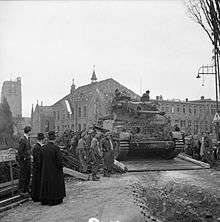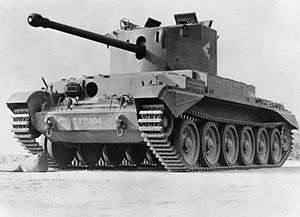Cruiser Mk VIII Challenger
| Tank, Cruiser, Challenger (A30)[1] | |
|---|---|
|
Cruiser tank Challenger (A30) | |
| Type | Cruiser tank |
| Place of origin | United Kingdom |
| Service history | |
| Used by |
United Kingdom |
| Production history | |
| Designer | Birmingham Carriage & Wagon Company |
| Number built | 200 |
| Specifications | |
| Weight | 31.5 long tons (32.0 t)[3] |
| Length | 26 ft 4 in (8.03 m)[3] |
| Width | 9 ft 6.5 in (2.91 m)[3] |
| Height | 8 ft 9 in (2.67 m)[3] |
| Crew | 5 (Commander, gunner, loader, co-loader, driver) |
|
| |
| Armour | 20–102 mm (0.79–4.02 in) |
Main armament |
Ordnance QF 17 pounder (76 mm) 42 rounds |
Secondary armament | 0.30 in Browning machine gun[4] |
| Engine |
Rolls-Royce Meteor V-12 petrol engine 600 hp (450 kW) |
| Power/weight | 18.8 hp (14 kW) / tonne |
| Suspension |
Christie suspension 6 road wheels |
Operational range | 105 mi (169 km)[3] |
| Speed | 32 mph (51 km/h)[3] |
The Tank, Cruiser, Challenger (A30) was a British tank of World War II. It mounted the QF 17-pounder anti-tank gun on a chassis derived from the Cromwell tank to add heavier anti-tank firepower to the cruiser tank units.
The design compromises made in fitting the large gun onto the Cromwell chassis resulted in a tank with a powerful weapon, but with less armour. The extemporised Sherman Firefly conversion of the US-supplied Sherman was easier to produce and, combined with delays in production, meant that only 200 Challengers were built. However, it was able to keep up with the fast Cromwell tank and was used alongside them.
History
The driving force in the development of Challenger was W. A. Robotham. Roy Robotham had been a Rolls-Royce executive in the car division who, with no work to do, had led a team to develop a tank powerplant from the Rolls-Royce Merlin aircraft engine. The Rolls-Royce Meteor gave the British a powerful, reliable engine, which would power the A27M Cruiser Mk VIII Cromwell tank. Robotham's contributions gained him a place in the Ministry of Supply and on the Tank Board, despite his lack of experience in tank design.[5]
The General Staff brought forward specification A29 for a 45-ton 17-pounder-armed cruiser tank based on needs identified in the African desert campaign. The design weight of this vehicle was too heavy however, and prior to manufacture the specification was passed over in favour of the alternate specification, A30 at 10 tons lighter.[6]
In 1942, an order for an A30 based tank was placed with Birmingham Railway Carriage and Wagon Company (BRC&W) expecting it to be based on the Cromwell components also being manufactured by BRC&W. Turret and gun mounting was in the hands of Stothert & Pitt. Birmingham Carriage had to modify the Cromwell hull to take a bigger turret.
The design received additional emphasis when it was found in May 1943 that the Cromwell was not going to be able to fit its intended armament. Vickers had been developing a 50-calibre-long 75mm "High Velocity" tank gun. It was realised late in the design process that the Cromwell's turret ring was too small to mount this 75 mm (3.0 in) gun.[7] Thus the Challenger would be the only British cruiser tank to mount a weapon that could tackle heavier German armour until the arrival of the A34 Comet.
British tank production was a limited resource however, and insufficient numbers could be made. In the lead-up to D-Day, Sherman tanks were upgraded with the 17-pounder creating the interim Sherman Firefly. Conversions of Sherman tanks to Fireflys was simpler than production of Challenger, and the A30 order was cancelled after about 200 had been built allowing BRC&W to focus on production of the Cromwell.
The tank was rendered obsolete when the Vickers HV 75 mm gun was developed to become the 77mm HV (actually 76.2 mm calibre) to arm the Comet tank. The 77mm HV used the same projectiles as the 17-pounder although with a reduced propellent charge compared to the 17-pdr. The 17-pdr was briefly used on earlier marks of Cromwell's successor -the Centurion tank.
Design

The turret mounted the Ordnance QF 17-pounder gun required in the Tank Board specification. The hull machine gun was removed to provide stowage space for the long 17 pounder cartridges. It was expected this larger ammunition, together with its stowage forward, would require two loaders. To fit the large weapon and a second loader, a turret larger than that of the Cromwell was required.
To fit the larger turret, the hull had to be lengthened and an extra road wheel added. This change in length, without a corresponding change in width across the tracks, reduced mobility compared to the Cromwell. To limit the weight, the amount of armouring was reduced, which was not possible on the hull, so it was reduced on the turret - 63 mm on the front and 40 mm on the side compared to 75 mm and 60 mm on the Cromwell. As the base of the turret was unprotected, a jacking feature was fitted to clear any jam resulting from enemy action.
The first Challenger was completed in 1942 and when the second was tested at Lulworth, it was criticised that, although it would be effective at long range against the current best-gunned tank in German service (the Panzer IV "Special" with the long 75 mm gun), at shorter ranges it would be at a disadvantage due to slow firing rate and thin armour.
An order for 200 was placed in February 1943, but in November, it was announced that no more would be ordered.
Service

The vehicle entered front-line service with the allied invasion of Normandy. No provision had been made for deep wading trunking and the A30 was unable to participate in the Normandy landings. Challenger crews had to wait until the Mulberry harbours were built and ports captured.
It was initially unpopular, with crews complaining about tracks being thrown, lack of armour and the high silhouette.[8] Troops used to the low profile of the Crusader and Cromwell found the high profile a major problem, although it was still shorter than the comparable Sherman Firefly. The track throwing problem was effectively addressed in-service however, and confidence in the vehicle increased.[9]
The Challenger and Firefly were armed with the 17-pounder and were used as an addition to tank squadrons, to deal with heavy tanks. Many were issued to units using Cromwells, simplifying maintenance as they shared many parts. The Challenger was liked better than the Firefly by its crews as it was faster and more manoeuvrable, while the Firefly had an even larger silhouette. Unfortunately however, the early bad reputation persisted.[10]
Other allied forces were issued with the Challenger, the 1st Polish Armoured Division receiving several in mid-1945 and the 1st Czechoslovak Armoured Brigade using it during the siege of Dunkirk in late 1944.[11][12]
After the war, the Czechoslovak government purchased 22 Challengers from the brigade inventory, which served in the Czechoslovak army (first with 11th, later with 23rd Tank Brigade and then the 13th Independent Tank Battalion) until they were put in reserve in 1951 and scrapped in 1959.[13]
Variants
A30 Avenger SP2 or SP 17pdr, A30 (Avenger) was a variant on the Challenger idea with a differently shaped open topped (though protection against air bursting shells was added later) turret to help reduce weight and give a lower profile on a lower profile hull. With priority production at Vauxhall Motors for the Comet tank, those built in 1945 were not ready for use until after the end of the war in Europe. Some 250 were built and these formed part of the British Army of the Rhine in Germany.
Survivors
Two vehicles survive. One is at the Overloon War Museum in the Netherlands. The other is awaiting restoration at the Isle of Wight Military Museum in the United Kingdom. Once restored, it will be displayed at the Bovington Tank Museum.[14]
References
- ↑ Bishop, Chris (1998). The Encyclopedia of Weapons of World War II. New York: Barnes & Noble. p. 27. ISBN 978-0-7607-1022-7.
- ↑ Fletcher Cromwell Cruiser Tank 1942-1950 p.42
- 1 2 3 4 5 6 White (1963), p. 54.
- ↑ Fletcher Cromwell Cruiser Tank 1942-1950 p.38
- ↑ Fletcher (1993)
- ↑ http://www.historyofwar.org/articles/weapons_cruiser_tank_A29.html ; retrieved 18 June 2016
- ↑ Fletcher, D and Harvey, R C Cromwell Cruiser Tank 1942-1950; ; Osprey Publishing
- ↑ Note from Service Engineer, 15.11.44; AA.2/JB.11.11.44
- ↑ Track Throwing, 15.11.44; Rm/GB.5/SW.15.11.44
- ↑ The Rolls Royce Meteor - Cromwell and other applications; Historical Series No. 35 published by the Rolls Royce Heritage Trust
- ↑ Hayward The Other Challenger quoting Six Monthly RAC Progress Reports
- ↑ Fletcher Cromwell Cruiser Tank 1942-1950 p 47
- ↑ Francev, Vladimír (2012). Československé tankové síly 1945-1992. Prague: Grada. p. 186. ISBN 9788024740294.
- ↑ Pierre-Olivier Buan (25 October 2011). "Surviving Cruiser Tanks" (PDF). Surviving Panzers website. p. 39. Retrieved 5 November 2011.
Bibliography
- Bingham, James (1971). AFV Profile No. 25 Cromwell and Comet. Profile Publishing.
- Boyd, David. "The Challenger Tank (A.30)". wwiiequipment.com.
- Evans; McWilliams; Whitworth; Birch (2004). The Rolls Royce Meteor. Rolls-Royce Heritage Trust. ISBN 1-872922-24-4.
- Fletcher, David (1993). The Universal Tank. HMSO. ISBN 0-11-290534-X.
- Fletcher, David (2006). Cromwell Cruiser Tank 1942-1950. Osprey Publishing. ISBN 1841768146.
- Hayward, M. "The Other Challenger". Shermanic Firefly.
- White, B T (1963). British Tanks 1915-1945. Ian Allan.
External links
| Wikimedia Commons has media related to Challenger A30 tank. |
